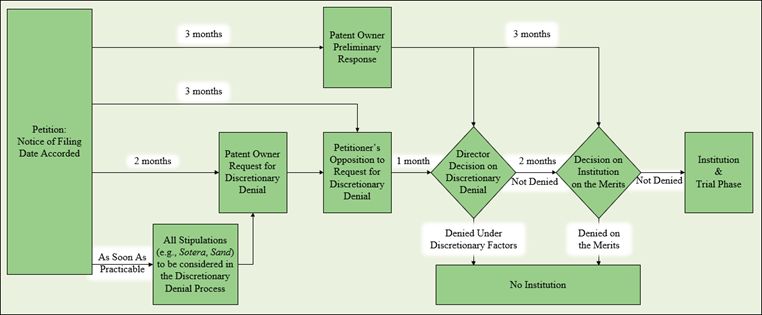On April 17, 2025, the PTAB held a Boardside Chat discussing the newly announced discretionary denial procedures outlined in the Interim Processes for PTAB Workload Management (Process Memorandum). On April 25, 2025, the PTAB published the recording and slides from the Boardside Chat on the USPTO website. Read our analysis and impressions from the chat here.
On the same day, the Board published the anticipated Frequently Asked Questions for Interim Processes for PTAB Workload Management (FAQ). This FAQ addresses many of the same issues from the Boardside Chat, but also includes answers to important questions the Board did not previously address.
As we previously wrote, Acting Director Stewart issued a memo on March 27, 2025, setting forth a bifurcated framework separating discretionary denial considerations from merit considerations at institution. Under the new procedures, the Director, in consultation with three senior Administrative Patent Judges (APJs), will determine whether discretionary denial is appropriate and, separately, a panel of three APJs will evaluate the merits. In this discussion, we highlight key takeaways from the FAQ and note a few important clarifications on the previous guidance.
- Can the parties stipulate to later due dates for discretionary considerations briefing?
To ensure statutory deadlines are met, the parties may not stipulate to later due dates for filing the discretionary considerations briefing. A party, however, may file its discretionary denial brief or an opposition before the due date.
No extensions. To comply with statutory deadlines, parties are not permitted to stipulate extension of the due dates for discretionary denial briefing. This differs from the Board's typical practice for briefing post-institution, where the parties are generally free to negotiate an alternative schedule so long as it will not affect the hearing date.
- How will the timing change if a patent owner files its discretionary denial brief early? For example, if a patent owner files its discretionary denial brief early enough, will a petitioner's opposition brief be due, and the Director's decision on discretionary considerations issue, before the POPR due date?
The timing will not change if a patent owner files its discretionary denial brief early. A petitioner opposition will be due within 1 month of the due date for a patent owner discretionary denial brief (i.e., on the POPR due date) and the Director's decision will not issue until after a patent owner files its POPR or the deadline for filing the POPR has passed.
Briefing dates will not shift. Contrary to how the Process Memorandum was previously interpreted, the timing for the petitioner's brief is not contingent upon when the patent owner files its preliminary response. Rather, the petitioner's brief is due one month after the due date for the patent owner's brief, which is two months after the Notice of Filing Date Accorded (NOFDA), i.e., concurrent with the deadline for the Patent Owner's Preliminary Response (POPR).
This change effectively moots any patent owner early filing strategies. For instance, a patent owner may have previously considered filing near the date of the NOFDA, aiming to prompt an early institution decision or to obtain the petitioner's brief in advance of the POPR deadline. Now, an early filing will not shift the petitioner's opposition date, or the Director's decision, which will be after the POPR deadline.
- In cases where the bifurcated process is available, will the Director issue a decision on discretionary considerations in every case, or only those where patent owner files a discretionary denial brief?
If a patent owner chooses not to file a discretionary denial brief, the Director will not issue a decision on discretionary considerations. In that situation, the Office will enter a notice into the docket indicating the case is now before a Board panel to consider the non-discretionary issues.
After such a notice is entered, a Board panel will issue a decision on institution addressing the merits and other non-discretionary considerations the parties have raised in the petition, a POPR, and any additional briefing that the Board panel has authorized. Unless otherwise authorized by the Director, the Board panel will not address discretionary considerations, except where the petition presents an insufficient number of challenges that meet the reasonable likelihood standard indicating that institution is an inefficient use of resources, as explained in Chevron Oronite Co. LLC v. Infineum USA L.P., IPR2018-00923, Paper 9 (PTAB Nov. 7, 2018) (informative) ("Chevron") and Deeper, UAB v. Vexilar, Inc., IPR2018-01310, Paper 7 (PTAB Jan. 24, 2019) (informative) ("Deeper").
No Sua Sponte Discretionary Denial Decisions. If the patent owner does not file a discretionary denial brief, the Director will not issue a decision on discretionary considerations. There was some ambiguity previously whether the Director would still take up discretionary denial issues sua sponte, but this FAQ seems to clarify she will not.
The Board panel will still consider Chevron / Deeper discretionary denials. Unless otherwise authorized by the Director, the Board panel will not address discretionary considerations. The exception is that the Board panel will retain discretion to deny a petition that presents an insufficient number of meritorious challenges, using the standards set forth in Chevronand Deeper.
Chevron and Deeper were both designated informative April 5, 2019. In both, the Board discretionarily denied institution for the entire petition where only a limited subset of the challenges presented demonstrated a reasonable likelihood of success (in Chevron, 2 of 20 claims, and in Deeper, 2 of 23 claims and only one of four grounds). This discretionary mechanism is largely a response to the implications of SAS Institute Inc. v. Iancu, 584 U.S.357 (2018)—while the Board must institute on all challenged claims if it institutes at all, it still retains the option to decline institution altogether.
Denying institution under this rationale necessarily requires a substantive evaluation of the merits across all challenged claims. Since the Director has indicated an intention not to engage in full merits analysis at the institution stage, this discretionary denial ground will remain with the Board panel. Notably, because this type of denial is based purely on the merits—and not on external factors like parallel litigation or timing—it typically does not require additional briefing by the parties.
- If the Director's discretionary consideration decision addresses the strength of the merits in a petition (e.g., as part of Fintivfactor 6), is the Board panel bound by such findings or conclusions in rendering a decision on institution?
A Board panel is not bound by merit findings or conclusions in a discretionary consideration decision but must explain in the decision on institution why the panel's findings and/or determination are different (citing the parties' evidence of record as relevant), if that occurs.
Director guidance on the merits is not binding. When a discretionary denial decision addresses the merits—e.g., as part of Fintiv factor 6—the subsequent Board panel is not bound by those earlier findings. However, if the panel reaches a different conclusion on the merits at institution, it must explain the divergence and cite relevant evidence from the record. It will be worth watching to see how often a Board panel differs in practice, given that its decision on institution is appealable to the Director.
- When should a petitioner file a Soteraor Sand stipulation if they wish to do so? What happens if a petitioner files a Soteraor Sand stipulation after the Director issues a decision on discretionary considerations?
A petitioner should file a Sotera or Sand stipulation as soon as practicable, so that a patent owner may address the impact of the stipulation in its discretionary denial brief. The Director will take into account whether the stipulation materially reduces overlap between the proceedings. Where the petitioner is relying on corresponding system art in a co-pending proceeding and/or several other invalidity theories, a stipulation may not be particularly meaningful because the efficiency gained by any AIA proceeding will be limited.
No specified deadline for stipulations. Stipulations—such as Sotera or Sand stipulations—should be filed "as soon as practicable" to allow the patent owner to address their impact in a discretionary denial brief. Notably, this guidance differs from the one-month-from-NOFDA timeline suggested in the recent Boardside Chat. While there is no set deadline for stipulations, and circumstances will vary from case to case, petitioners are likely better positioned to file early if a stipulation is going to be made. Additionally, the Director will consider whether the stipulation materially reduces the overlap with parallel proceedings. Thus, if the petitioner continues to rely on corresponding system art or multiple invalidity theories in co-pending litigation, the stipulation may have limited impact, as any efficiency gains from the AIA proceeding are reduced.
- Who decides pro hac vice motions and other procedural motions that do not relate to discretionary considerations?
The Board panel will decide procedural motions that do not relate to discretionary considerations regardless of when those motions are filed. To facilitate resolution of procedural motions, the PTAB will assign a Board panel to the case before the Director issues a decision on discretionary decisions. That Board panel will decide all procedural motions.
The Board panel will be assigned as normal. The PTAB will assign the Board panel at the outset—before the Director issues a decision on discretionary denial—so it can also decide procedural motions unrelated to discretionary considerations. While this approach differs from what was stated last week (that the Board panel would not be assigned until after the Director's discretionary denial decision), it is a practical adjustment that ensures procedural issues are addressed without delay.
- How does the extent of the petition's reliance on expert testimony bear on discretion to institute IPR or PGR?
While the Board may consider expert testimony, as a matter of efficiency, extensive reliance on expert testimony and/or reasonable disputes between experts on dispositive issues may suggest that the questions are better resolved in an Article III court. The statute and our reviewing court require that petitions be based on prior art patents and printed publications. As the judges have technical and legal expertise, it is not necessary for an expert to explain every aspect of the prior art. It is most helpful if an expert is providing focused testimony, for example to provide helpful context or to explain terms of art. The failure to provide focused expert testimony may weigh against institution.
Too much "Reliance on Expert Testimony" may support denial. In the Process Memorandum, "[t]he extent of the petition's reliance on expert testimony" was listed as a factor that could support denial, but without any elaboration on its scope. The FAQ provided some context for this factor and explained the need for "focused expert testimony" in petitions. The FAQ noted that APJs "have technical and legal expertise [and] it is not necessary for an expert to explain every aspect of the prior art." It appears the Director may discretionarily deny petitions that rely too heavily on expert testimony to support every statement." This approach may contrast with typical practice—commonly used by both petitioners and patent owners—where expert testimony has often been used to neutralize attacks that prior art characterizations in briefs are simply "attorney argument." It also appears that the Director may discretionarily deny petitions when there are "reasonable disputes between experts on dispositive issues," which the FAQ characterizes as "questions that [may be] better resolved in an Article III court."
- May a discretionary denial brief or opposition include arguments relating to merits or claim construction?
The parties should not treat a discretionary denial brief or opposition as an additional opportunity for merits briefing.
Notwithstanding the prohibition on incorporation by reference in 37 C.F.R. § 42.6(a)(3), when filing a brief for discretionary denial, a patent owner may direct attention to an anticipated POPR and evidence for a discussion of the merits. Similarly, in arguing about the strengths or weaknesses of the merits, the parties may refer to arguments made in the petition and cite to record evidence. As explained above in response to FAQ 8, the Director will receive the petition, the POPR, and the parties' discretionary briefing. Thus, the Director will consider the merits arguments made in the petition and the POPR when relevant to the discretion determination.
The parties' discretionary briefing may also address claim construction if it is relevant to the discretionary considerations.
The Director will consider the merits briefing. As outlined previously, the discretionary denial briefing and related Director decision are separate from the merits briefing and the Board panel decision at institution. The Board panel will no longer consider any discretionary denial factors, and the Director will not consider the merits except to the extent they form part of the parties' dispute regarding discretionary denial (e.g., Fintiv Factor 6). However,the Director will have access to and consider the petition, the POPR, and the evidence cited therein in determining whether discretionary denial is appropriate. This is in contrast to the strict delineation between the two processes discussed at the Boardside Chat.
The Patent Owner's brief can reference the to-be-filed POPR. According to the FAQ, patent owners are allowed to reference the POPR in discussing the merits, rather than repeat all arguments in the discretionary denial briefing. While this includes a caution that the prohibition on incorporation by reference in 37 C.F.R. § 42.6(a)(3) has not been rescinded, it remains unclear how petitioners are expected to respond to patent owner positions from the POPR, as the petitioner's opposition is due the same day as the POPR. The FAQ, like the discussion during the Boardside Chat cautions the parties to "not treat a discretionary denial brief or opposition as an additional opportunity for merits briefing. It is not clear how this will play out in practice but tends to suggest that the Director may take an independent view of the parties' positions in petition and POPR when considering if discretionary denial is appropriate.
- Can parties introduce evidence with their discretionary briefing and, if so, what evidence can they introduce?
Yes. The parties may introduce evidence relevant to the discretionary issues raised in their briefing. However, parties should keep in mind that the Director will consider the petition, the POPR, and the evidence cited therein in determining whether discretionary denial is appropriate.
Exhibits are allowed but need not be repeated. The Board clarified the parties can submit exhibits for evidence related to the discretionary denial briefing. However, as the Director will have access to the evidence included with the Petition and POPR, the parties do not need to create duplicative exhibits solely for the new process.
Updated Discretionary Denial Process Timeline:

The content of this article is intended to provide a general guide to the subject matter. Specialist advice should be sought about your specific circumstances.



